Norma constellation lies in the southern sky, between the constellations Scorpius and Centaurus.
Its name means “normal” in Latin (referring to a right angle) and it represents a level, a set square, a rule, or a carpenter’s square. The constellation was introduced by the French astronomer Nicolas Louis de Lacaille in the mid-18th century. Lacaille originally named the constellation l’Equerre et la Regle, after a draughtsman’s set-square and rule. Norma is one of the smaller constellations and does not have any prominent stars. It is home to the Norma Cluster of galaxies, the bipolar Ant Nebula, the Fine Ring Nebula, and the open clusters NGC 6067 and NGC 6087, among other objects.
Facts, location and map
Norma is the 74th constellation in size, occupying an area of 165 square degrees. It is located in the third quadrant of the southern hemisphere (SQ3) and can be seen at latitudes between +30° and -90°. The neighboring constellations are Ara, Circinus, Lupus, Scorpius and Triangulum Australe.
The constellation name Norma is pronounced /ˈnɔːrmə/. In English, the constellation is known as the Carpenter’s Square. The genitive form of Norma, used in star names, is Normae (pronunciation: /ˈnɔːrmiː/). The three-letter abbreviation, adopted by the International Astronomical Union (IAU) in 1922, is Nor.
Norma belongs to the Lacaille family of constellations, along with Antlia, Caelum, Circinus, Fornax, Horologium, Mensa, Microscopium, Octans, Pictor, Reticulum, Sculptor, and Telescopium.
Norma contains four stars with known planets and has no Messier objects. The brightest star in the constellation is Gamma-2 Normae, with an apparent magnitude of 4.02. There is one meteor shower associated with the constellation; the Gamma Normids.
Norma does not contain any formally named stars.
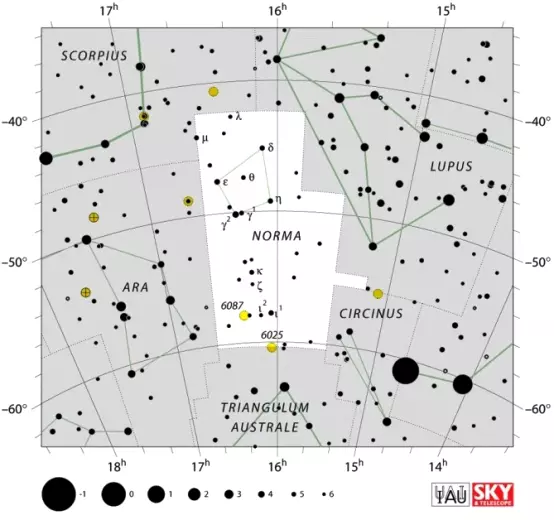
Norma constellation map by IAU and Sky&Telescope magazine
Story
Norma constellation is not associated with any myths. It was introduced by Nicolas Louis de Lacaille in the 1750s, during his stay at the Cape of Good Hope in South Africa, where he was mapping the southern skies. Lacaille created the constellation out of faint stars between Lupus and Ara and originally named it l’Equerre et la Regle, referring to a draughtsman’s set-square and rule.
The constellation represents a carpenter’s square, used by carpenters on exploratory vessels. The constellation’s name was Latinized to Norma et Regula, and eventually shortened to Norma.
As the constellation boundaries have changed since the 18th century, Norma no longer has stars designated Alpha or Beta. The stars that were Alpha and Beta Normae in Lacaille’s time now belong to Scorpius constellation and are designated N and H Scorpii.
Norma stars
γ Normae (Gamma Normae)
Gamma Normae is an optical double star composed of Gamma-1 Normae and Gamma-2 Normae, two line-of-sight companions.
Gamma-2 Normae, itself a close optical binary, is the brightest star in the constellation. It has the stellar classification of G8III, matching the spectrum of a yellow giant star. It has an apparent magnitude of 4.02 and is approximately 127 light years distant from Earth.
Gamma-1 Normae is a yellow-white supergiant belonging to the stellar class F9Ia. It has an apparent magnitude of 5.09 and an absolute magnitude of -3.25. The star is 1,436 light years distant from the solar system.
ε Normae (Epsilon Normae)
Epsilon Normae is a binary star with the stellar classification of B4V, matching the spectrum of a blue-white main sequence dwarf. It has a visual magnitude of 4.53 and is approximately 400 light years distant from the Sun. The dimmer star in the system is itself a spectroscopic binary.
ι1 Normae (Iota-1 Normae)
Iota-1 Normae is a white subgiant star with the stellar classification of A7IV. It has an apparent magnitude of 4.63 and is about 140 light years distant from Earth. It is a really a multiple star. It consists of a rapid binary star with an orbital period of 26.9 years and a third component that lies in the same line of sight but is only 55 light years distant from Earth. Components A and B have apparent magnitudes of 5.6 and 5.8, and component C, 8.75.
η Normae (Eta Normae)
Eta Normae is a yellow giant star belonging to the stellar class G8III. It has a visual magnitude of 4.65 and is about 218 light years distant from the Sun.
δ Normae (Delta Normae)
Delta Normae is a white, A-class star about 123 light years from Earth. It has an apparent magnitude of 4.73.
μ Normae (Mu Normae)
Mu Normae is a blue-white supergiant in Norma. It has the stellar classification of B0Ia and is 4,657.13 light years distant from the Sun. It has a visual magnitude of 4.914 and an absolute magnitude of -5.86, which means that it is about 210,000 times more luminous than the Sun. The star is a suspected variable of the Alpha Cygni type. Its magnitude varies from 4.87 to 4.98.
Mu Normae has a mass 30 times solar and a radius 15.4 times that of the Sun. The star’s estimated age is about 4 million years.
κ Normae (Kappa Normae)
Kappa Normae has the stellar classification of a yellow giant star, G8III. It has an apparent magnitude of 4.94 and is approximately 438 light years distant from the solar system.
R Normae
R Normae is a Mira variable, a pulsating red giant star that will expel its outer envelope to form a planetary nebula and become a white dwarf in the next few million years.
It has the stellar classification of M3e and is approximately 600 light years distant from the Sun. The star has a mean apparent magnitude of 8.0, and its magnitude ranges from 6.5 to 13.9 with an average period of 507.5 days.
S Normae (47 G. Normae)
S Normae is a Cepheid variable, a luminous variable star with the stellar classification of F9Ib. Its visual magnitude ranges from 6.12 to 6.77 over a period of 9.75411 days.
The star is approximately 2,741 light years distant from Earth. It has a radius 41 times solar, a mass 4.8 to 7.3 times solar, and is 2,800 times more luminous than the Sun. The star has an absolute magnitude of -3.18.
S Normae is located at the centre of the open cluster NGC 6087, which is also known as the S Normae Cluster.
HD 142415
HD 142415 is a yellow main sequence star with the stellar classification of G1V. It has an apparent magnitude of 7.34 and is 113 light years distant from the Sun. The star has 1.09 times the Sun’s mass and 1.1 times the luminosity. It is believed to be about 1.5 billion years old.
A planet with at least 1.62 times the mass of Jupiter is orbiting the star with a period of 386.3 days.
HD 148156
HD 148156 is another yellow main sequence star with a confirmed planet in its orbit. The star belongs to the spectral class G1V and has a visual magnitude of 7.71. It is approximately 168 light years distant from Earth. It has a mass 1.15 times that of the Sun and a radius 1.28 times solar. It is 1.902 times more luminous than the Sun.
A gas giant with at least 85 percent of Jupiter’s mass was discovered orbiting the star in 2009. The planet completes an orbit every 1,027 days.
HD 143361
HD 143361 is a binary star with an apparent magnitude of 9.20. It is about 210 light years distant from the Sun. It has the stellar classification of G6 V, matching the spectrum of a yellow main sequence dwarf. The primary component has a red, M-class companion about 30.9 astronomical units away.
A planet with at least 3.12 times the mass of Jupiter was discovered orbiting the star in October 2008. The planet has an orbital period of 1,057 days.
HD 330075
HD 330075 is another yellow dwarf with a confirmed planet. It belongs to the spectral class G5 and has an apparent magnitude of 9.36. The star is 163.7 light years distant from Earth. It has about 95 percent of the Sun’s mass and an estimated age of 6.21 billion years It is slightly less luminous than the Sun.
A hot Jupiter planet was discovered orbiting the star in 2004. The planet has a mass 0.76 times that of Jupiter and it completes an orbit around the star every 3.369 days.
Deep sky objects in Norma
Ant Nebula – Mz 3 (Menzel 3)
The Ant Nebula, or Menzel 3, is a bipolar planetary nebula in Norma. It has an apparent magnitude of 13.8 and is approximately 8,000 light years distant from the solar system. It got the nickname the Ant Nebula because its shape resembles the head and thorax of an ant.
The nebula has a bright core and is believed to have a symbiotic binary star at its centre. It was discovered by the American astronomer and astrophysicist Donald Howard Menzel in 1922.
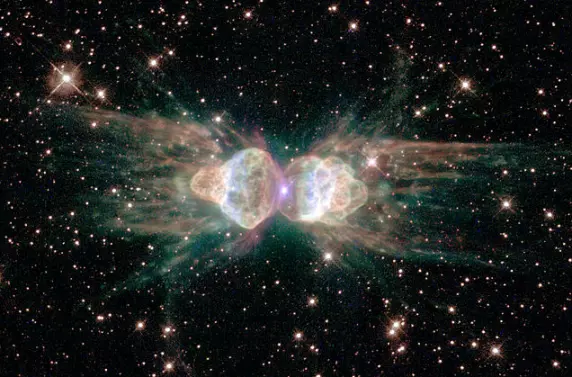
Ant Nebula – This NASA/ESA Hubble Space Telescope image reveals the ant’s body as a pair of fiery lobes protruding from a Sun-like star in its final stages. The ejection of gas from the star at the center of Mz3 has intriguing symmetrical patterns unlike the chaotic patterns expected from an ordinary burst. Scientists using the Hubble space telescope would like to understand how a spherical star can produce such prominent, non-spherical symmetries in the gas that it ejects. One possibility is that the central star of Mz3 has a closely orbiting companion that exerts strong gravitational tidal forces, which shape the outflowing gas. For this to work, the orbiting companion star would have to be close to the star, about the distance of the Earth from the Sun. At that distance the orbiting companion star wouldn’t be far outside the hugely bloated hulk of the central star. It’s even possible that the star has consumed its companion, which now orbits inside of it, much like the duck in the wolf’s belly in the story “Peter and the Wolf.” A second possibility is that, as the central star spins, its strong magnetic fields are wound up into complex shapes. Charged winds moving at speeds up to 1000 kilometers per second from the star, are able to follow the twisted field lines on their way out into space. These dense winds can be rendered visible by ultraviolet light from the hot central star or from highly supersonic collisions with the ambient gas that excites the material into fluorescence. Image: NASA, ESA & the Hubble Heritage Team
NGC 6067
NGC 6067 is an open cluster in Norma. It has an apparent magnitude of 5.6 and is 4,621 light years distant from Earth. The cluster lies just to the north of the star Kappa Normae. It is 12′ in diameter. It can easily be seen with binoculars or a small telescope.
S Normae Cluster – NGC 6087 (Caldwell 87)
NGC 6087 is an open cluster consisting of 40 or more stars in Norma constellation. It has an apparent magnitude of 5.4 and is approximately 3,500 light years distant from the Sun.
The cluster is centred on the star S Normae, which is also the brightest star in NGC 6087, and spans an area of almost a quarter of a degree.
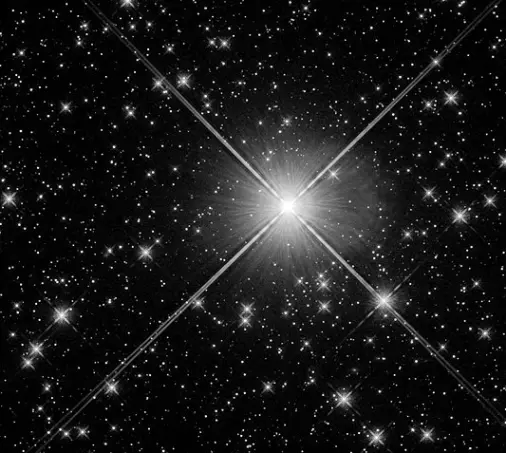
This shining collection of stars captured in infrared light by Hubble’s Wide Field Camera 3 is part of Caldwell 89, also known as NGC 6087. This open cluster consists of approximately 40 stars, the brightest of which (near the center here) is the variable star S Normae. Cepheid variable stars like S Normae change brightness at a regular and predictable rate. There is also a relationship between a Cepheid’s pulsation rate and its intrinsic brightness. A Cepheid’s pulsation rate tells us how bright it truly is, so how bright it appears to us tells us how far away it is. (The farther a Cepheid is, the dimmer it appears.) This makes Cepheids important “standard candles” for measuring distances in the universe. Hubble’s observations of Caldwell 89 were made to improve the calibration of S Normae as a standard candle. Image: NASA, ESA, and A. Riess (Johns Hopkins University); Processing: Gladys Kober (NASA/Catholic University of America)
Fine Ring Nebula – Shapley 1 (Sp-1, PK 329+02.1)
The Fine Ring Nebula, or Shapley 1, is an annular planetary nebula in Norma constellation. The nebula has a visual magnitude of 12.6. It is about 1,000 light years distant from Earth. The central star is a magnitude 14 white dwarf.
The Fine Ring Nebula was discovered by the American astronomer Harlow Shapley in 1936. It is 1.1 arc minutes in diameter, or about a third of a light year across.
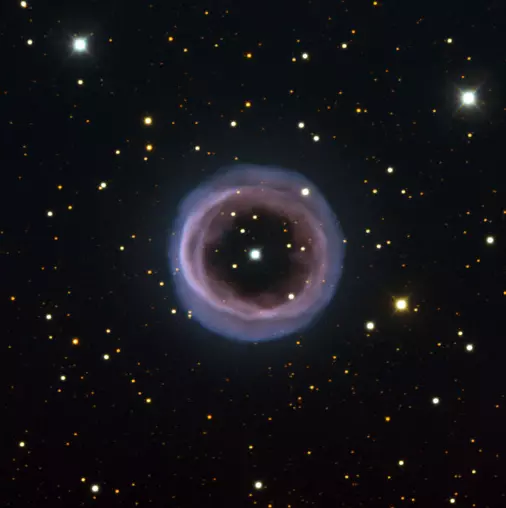
The hazy and aptly named Fine Ring Nebula, shown here, is an unusual planetary nebula. Planetary nebulae form when some stars in their final stages, having expanded into a red giant phase, expel a shell of gas as they evolve into white dwarfs. Most planetary nebulae are either spherical or elliptical in shape, or bipolar (featuring two symmetric lobes of material). But the Fine Ring Nebula — captured here by the ESO Faint Object Spectrograph and Camera mounted on the New Technology Telescope at the La Silla Observatory in Chile — looks like an almost perfect circular ring. Astronomers believe that some of these more unusually shaped planetary nebulae are formed when the progenitor star is actually a binary system. The interaction between the primary star and its orbiting companion shapes the ejected material. The stellar object at the centre of the Fine Ring Nebula is indeed thought to be a binary system, orbiting with a period of 2.9 days. Observations suggest that the binary pair is almost perfectly face-on from our vantage point, implying that the planetary nebula’s structure is aligned in the same way. We are looking down on a torus (doughnut shape) of ejected material, leading to the strikingly circular ring shape in the image. Image: ESO
Norma Cluster – Abell 3627
The Norma Cluster is a rich galaxy cluster in Norma. It is located about 221.1 million light years from Earth.
The cluster is very difficult to observe because it is obscured by dust and it lies in the Zone of Avoidance, a region of the sky that is obscured by the Milky Way Galaxy. The cluster lies near the Great Attractor, a gravity anomaly in intergalactic space which reveals a concentration of a huge unseen mass equal to tens of thousands of galaxies.
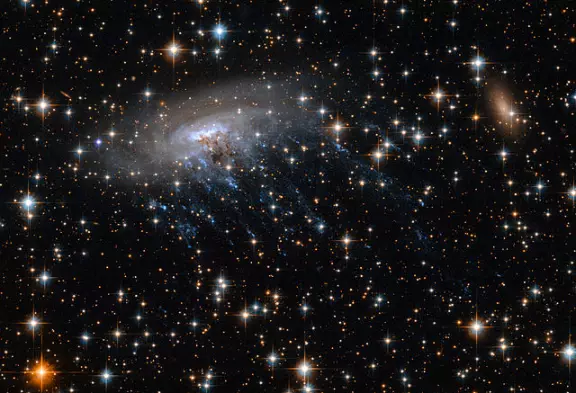
This new Hubble image shows spiral galaxy ESO 137-001, framed against a bright background as it moves through the heart of galaxy cluster Abell 3627. This image not only captures the galaxy and its backdrop in stunning detail, but also something more dramatic — intense blue streaks streaming outwards from the galaxy, seen shining brightly in ultraviolet light. Image: NASA, ESA; acknowledgements: Ming Sun (UAH), and Serge Meunier
Mz 1 (Menzel 1)
Mz 1 is a bipolar planetary nebula. It has an apparent magnitude of 12.0 and is approximately 3,400 light years distant from Earth.
The nebula has a prominent central ring and a shape of an hour-glass figure. The estimated age of the nebula is between 4,500 and 10,000 years. The nebula was discovered by Donald Howard Menzel in 1922.

Menzel 1, image: ESO
NGC 6021
NGC 6031 is an open star cluster. It has an apparent magnitude of 8.5 and is approximately 6,800 light years distant from the solar system. The cluster is about 250 million years old.
NGC 6167
NGC 6167 is another open cluster in Norma. It is located on the border with the constellation Ara. The cluster has a visual magnitude of 6.7.
NGC 6152
NGC 6152 is also an open star cluster. It was discovered by the English astronomer John Herschel on June 8, 1834. The cluster has an apparent magnitude of 8.1 and is approximately 3,360 light years distant from the solar system. It is 25’ in diameter.